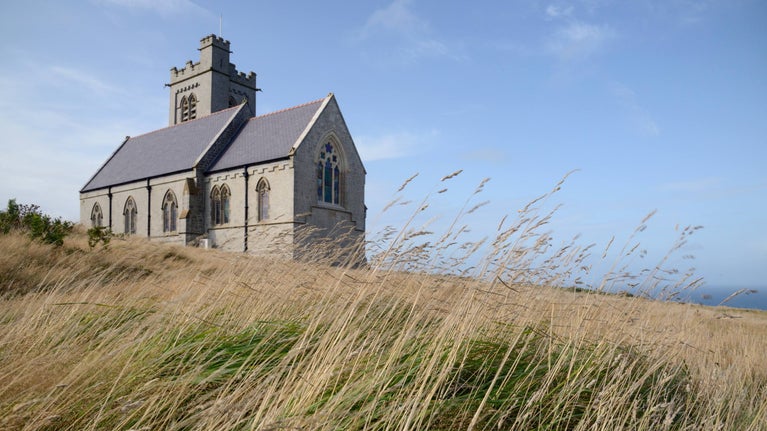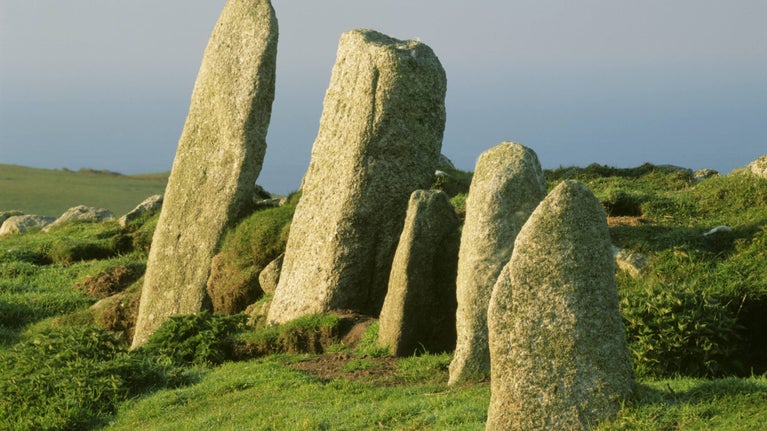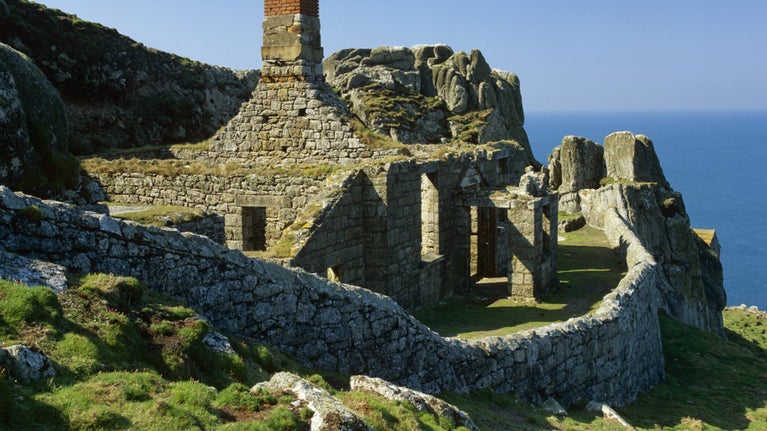History of Lundy
- Expert curated

Jump to
Lundy is a small island with a long and complex history, twelve miles off the coast of Devon, within the Severn estuary. Its location in shipping lanes towards the port of Bristol has made it a harbour for fishermen, smugglers, pirates and traders of enslaved people, as well as home to farmers and wealthier landowners. It has been a place of both intentional and forced isolation, and for some, a place of independence.
Ongoing occupation
Over 1300 archaeological sites are mapped on Lundy which measures just three miles long and half a mile wide. There are scatters of flint tools left by seasonal hunters in the Mesolithic, prehistoric hut circles, standing stones, burial sites, field systems and the first permanent settlements left by Bronze Age farmers, about 4000 BC. An early cemetery on Beacon Hill contains rare Christian gravestones of the fifth and sixth centuries and the ruins of monastic buildings. The remains of a 17th-century British Civil War castle and gun battery evidence the islands defensive importance with buildings from the 19th century onwards including lighthouses, a fog battery and a Victorian granite quarry with workers cottages and hospital.
Turbulent ownership
The settled residents of Lundy have seen the island change hands many times. Owned in the earlier 12th century by the de Newmarch family of Somerset Lundy was later leased to the de Mariscos also of Somerset but with extensive property in Ireland including Coonagh Castle in County Limerick.
When in 1160 King Henry II of England attempted to transfer title to the Knights Templar, the military order of the Catholic faith, the de Mariscos refused and aligning with the Scottish and French against the English, secured themselves on the island using it as a base for piratical activity and raids on the North Devon coast. In 1242, when William de Marisco (c.1200–42) was implicated in a plot against Henry III, captured and executed, Henry took the opportunity to build and garrison a castle on the island to prevent future threat.
Through the medieval period and into the 18th century, Lundy was acquired and owned through marriage or inheritance passing through several families. Some, such as the Montacute’s rarely if ever set foot on the island, instead many pirates and smugglers settled unlawfully. In 1608 a commission established by the Earl of Bath heard that ‘merchants were daily robbed at sea by pirates who took refuge at Lundy’. In 1610 a pirate called William Young, in a deposition to the Aldermen of Barnstaple who had been commissioned to address the issue of the pirates, recorded that he had declared himself king of Lundy.

Pirates, smugglers and enslavement
In 1625 Turkish pirates were reported to have captured the island and there were regularly Turkish and North African ships in the harbours. In 1627, while voyaging to Iceland, Murat Rais the Younger (c.1570–1641), a Dutch privateer originally known as Jan Janszoon, settled with his crew on Lundy. Named the Salé (Sallee) Rovers, they flew the flag of the Sale city state of Morrocco but were a global group of mixed nationalities and religions.
While English pirates were interested primarily in the cargo of the ships they secured, the Rovers set out to capture people to be enslaved and sold in the markets of the North African Barbary Coast. Raids stretched as far north as Iceland but many of those held on Lundy would have been from the villages of the Cornish and Devon coasts and sailors from cargo ships.
The Sale Rovers used Lundy intermittently for at least a decade and thousands were captured by these or other pirates. By 1636 local merchants petitioned that they would no longer take to sea unless a fleet was raised to protect the coastline and deter ships setting out from North Africa.
During the British Civil Wars (1642–51), Lundy was re-fortified and garrisoned for King Charles I at the personal expense of Thomas Bushell, a mining engineer who had been a servant of a previous Lord Chancellor, Francis Bacon. Lundy was the last Royalist territory held between the first and second British Civil Wars (1642–51). With permission from King Charles I, Thomas surrendered the island in 1647, the defenders being pardoned. By the 1660’s there were renewed reports of privateers operating from the island.
In 1750 Lundy was leased to Thomas Benson (1708–72) a ship owner and merchant. Sheriff of Devon and Member of Parliament for Barnstaple he was also a smuggler who dabbled in piracy and used the island to store his goods. These included convicts who he had contracted to transport to British colonies in North America but who were kept on the island and used as enslaved labourers. Eventually Thomas was caught in a shipping insurance fraud. He escaped and fled to Portugal leaving the captain of the ship involved to hang for the crime

The kingdoms of Heaven and Harman
William Hudson Heaven (1800–83) was a Bristol merchant and plantation owner who purchased Lundy in 1836. Like his father Thomas Heaven, William owned multiple plantations in Jamaica, possibly received from their ancestor William Hudson who had emigrated there in 1757.
With the profits of enslaved labour, William constructed Millcombe Villa on Lundy as a holiday home for his family. In 1863, perhaps in part to help pay for the costs of the island, he granted a lease to the Lundy Granite Company to open extensive quarries along the east coast. These are now one of the most complete surviving examples of a Victorian quarry complex. Lundy was inherited by Williams oldest son, Reverend Hudson Grosett Heaven (1826-1916). He became both teacher and minister for the island, building the church in 1883 and later a Sunday school.
In 1925 businessman Martin Coles Harman (1885-1954) achieved his childhood ambition when he purchased the island. His children became the final private owners. Martin believed that the island should be a self-governing part of the British Empire, recognising the King as its Head. He even issued stamps and coinage. Equivalent to an old penny or half penny they were struck with his own likeness and named ‘Puffin’s’, the Norse translation of ‘Lundy’ and an acknowledgement of the islands most famous visiting bird. When he was prosecuted by UK authorities for issuing illegal coinage in 1931 the coins were withdrawn but the stamps continued.
Public ownership
The Harmans encouraged tourists, opening the hotel and adapting buildings for holiday cottages. After Martin died in 1954 the island became increasingly unaffordable to manage. When his son Albion died in 1969 it was again for sale. A group of local politicians worked to find a new owner. Sir Jack Hayward (1923–2015), property developer and businessman bought Lundy for £150,000, gifting it immediately to the National Trust.
Lundy retains a small working community, all employed by The Landmark Trust, who have administered the island since 1969 and continued to develop the holiday accommodation. The island is nationally important for its bird nesting sites and the first UK national Statutory Marine Nature Reserve (MPA). The Landmark Trust and National Trust renewed their long-term partnership agreement in 2019.
Further reading
- Reagan, Romany. 2020. Pirates, Smugglers, Treason & a Fake King: The Scandalous History of Lundy Island https://blackthornandstone.com/2020/07/16/pirates-smugglers-treason-a-fake-king-the-scandalous-history-of-lundy-island/.
- University College London, Centre for the Study of the Legacies of British Slavery. Centre for the Study of the Legacies of British Slavery (CSLBS) | UCL Faculty of Social & Historical Sciences
You might also be interested in
Things to do on Lundy Island
Explore an unspoilt island, home to a wide array of wildlife amidst dramatic scenery. Stroll through the village, explore a historic landscape and discover a disused lighthouse.

Lundy Island wildlife walk
Take a boat trip to enjoy a circular island ramble around this car-free granite outcrop in the Bristol Channel, with wildlife including grey seals, rare puffins and sika deer.
